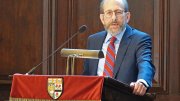A new master’s program and expansion of the M.D./Ph.D. program are two among many changes to emerge from the Harvard Medical School (HMS) strategic-planning process, which Dean Jeffrey S. Flier began last fall soon after taking office.
From the dozen reports produced and suggestions generated with the participation of more than 100 faculty members, retooling educational offerings emerged as a top priority. The one-year master’s program—leading to a master of medical science degree (M.M.Sc.)—debuts this fall on a pilot basis as an extra-year option for first-year medical students and rising second-year students. Nearly half of Harvard medical students already extend their education by a year to pursue a special interest or project, Flier notes, “but it tends not to be particularly organized.”
The program, with its formal structure and thesis requirement, goes hand in hand with a new mandate that all M.D. candidates—starting with the class that enters in 2010—complete a scholarly project. This change reflects the idea that Harvard and its students should regard advancing medicine, and not just professional training, as a critical goal. Students will have almost complete freedom of choice, but projects are expected to fall into three broad areas: basic biomedical research; clinical and translational research; and medicine and society (encompassing health policy, global health, and the history of medicine, among other things). “Some students may elect to pursue only the minimum four-month scholarly project requirement by writing up their work from a summer service-learning project,” members of the education review committee wrote; for others, the projects will kindle a flame that grows into a master’s thesis (see above) or a lifelong research interest.
Another of the review committee’s recommendations, expanding the M.D./Ph.D. program, was a no-brainer, says Flier: “We could easily double the size and not have any fall-off in the quality of the students.” The program admits 10 or 11 students a year; other qualified applicants are admitted to the M.D.-only program, but usually choose to go elsewhere. Federal funding covers the costs for current students, but admitting more (at the University’s own expense) will be costly, as will the master’s program. Flier says, hopefully, “We think this will get a lot of people’s attention from a philanthropic point of view.”
New entities whose missions cross disciplinary lines, but align closely with parts of HMS, are suddenly rife at the University—for instance, the Broad Institute of Harvard and MIT, created in 2003 to develop tools for genomics-based medicine, and the Harvard Stem Cell Institute, created in 2004. On the nascent Allston campus, opportunities for interfaculty collaboration are bound only to increase, but with those opportunities comes the responsibility to plan well for how, and where, such collaborations should take place. With undergraduates clamoring for courses in global health and bioengineering, and medical students hoping to capitalize on resources elsewhere at the University, Flier decided it was time to appoint a dean with a particular focus on matters interdisciplinary. Effective June 16, Thomas Michel, a cardiologist and professor of medicine who headed the strategic review committee on education, assumed the new position of dean for education. (Walter professor of medicine Jules Dienstag will remain dean for medical education.)
Other faculty working groups considered topics including global health; microbial sciences; neuroscience; aging; bioengineering; medical imaging; pharmacology; organizational structures; tools and technology; human genetics; immunology and inflammation; and the social sciences. The reports are all available at https://hms.harvard.edu/public/strategy; together, they constitute a wish list long enough to fill the duration of a deanship and beyond. Flier is still prioritizing, but he vows swift action, in some format, on bioengineering (see "The Liberal Art of Engineering"), pharmaceutical development, and global health—and he predicts a major announcement this fall in the area of human genetics, a field where, he says, “We have many of the leaders, internationally, at Harvard. They just haven’t been organized in a way that takes full advantage.”








